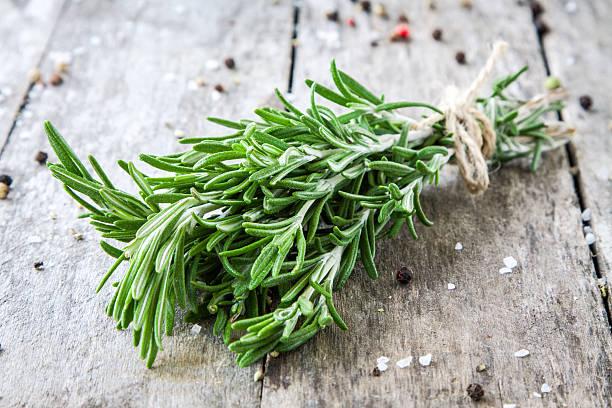Do you like to cook with fresh herbs? Then you’ve probably spent at least a fiver on those small, plastic sachets of limp, wilting rosemary or basil since this column began. You could just as easily have spent that money on securing a regular supply of actually fresh aromatics. Read on to learn how to grow rosemary indoors.
How to Care For Rosemary Indoors:
The good news is that most of your favorite herbs don’t require much in the way of care — rosemary in particular, is a bit of a masochist and loves nothing more than to be treated a little rough. While certain herbs like parsley, dill, basil or coriander must be purchased again and again as young specimens or re-sown from seed every other year or two, hardier perennials like rosemary, chives, thyme, mint, tarragon bay and oregano can live for upwards of four or five years. Rosemary has a reputation for being especially long-lived and can live for more than 30 years.
This is one of those select few times when the lazy, cheap way of doing things is actually the right way to do them: just pop by your nearest garden center (those pretty little pots of “growing” herbs you see at the grocery store are over-crowded with shallow-rooted seedlings that, when harvested, lack the pep and perk to put out any worthwhile new growth) as soon as you’re able and buy well-established plants that are mature enough to harvest immediately. Stay away from baby-plants, or you’ll just have to end up heading back to the grocery store while you wait for them to get settled and put out growth! The ideal specimen is sitting in a well filled 22-30 cm pot, or something resembling that!
How Much Sunlight Does Rosemary Need?

Back home, it’s time to move your rosemary plant into the sturdy, attractive container that’ll be its home for the remainder of its long life. We’ve written a great article on the best indoor herb garden kits. Choosing a sheltered spot with plenty of sun is imperative as rosemary grows best in full sun and needs at least five to six hours of direct light every day. Avoid over-watering and mollycoddling: unless the soil is extremely nutrient-poor, don’t bother trying to enrich it. Most herbs, including rosemary, are more aromatic and fragrant when you employ a sterner approach.
In the wild, herbs are toughened by the arid, hostile and barren conditions they’re often subject to, which might not sound all that conducive to growth but in fact, over-tending them at home will only result in weak plants with vastly diminished culinary value that won’t taste the way you want them to. You don’t even need to be very discerning about the sort of soil you’re growing them in! However, the one thing all herbs need is solid drainage.
How Often to Water Rosemary?
Rosemary, being a Mediterranean perennial, is no exception and does best in well-drained, loamy, slightly acidic soil — it’ll even take to the cactus potting mix. When trying to work out your soil’s drainage capacity, you’ll want to pour water on its surface until a puddle has formed, which should then ebb quickly away. If it doesn’t, you can improve drainage by adding coarse grit, compost, or even peat moss to help the water drain more quickly away from the surface to the subsoil, where there’s no risk of it water-logging roots.
In the event that your soil is highly acidic or more of a thick, nigh-impenetrable clay Frisbee than, well, soil — especially common in cities where most soil is more kitchen-spoils than dirt — rosemary is just as happy in pot or raised bed indoors as it might be in your garden. Window boxes, terracotta pots and roomy containers are all ideal options. If you’re an avowed minimalist too in love with stainless steel to ever consider opting for anything else, you’ll want to be sure you’ve lined your container with polystyrene sheeting to protect the plant’s roots from extreme heat.
Lay down a good 6-10cm thick layer of drainage material down first in the bottom of your container, then a mixture of soil-based compost and multi-purpose at a ratio of 60:40 (be sure to add drainage material too, one big handful for every spadeful of compost you put in there to prevent it from choking out the plant’s root system). A little room to grow, plenty of sun and regular watering — that’s all there is to it. Promise.
How To Trim Your Rosemary Bush: There’s Not A Whole Lot To It.

Woody, long-legged herbs like rosemary and thyme and lavender need careful pruning as they put out growth — lest you risk stumbling upon a wild, disheveled unkempt monster of a plant one morning. Left entirely unchecked, your rosemary plant is going to do what it does best: become leggy, with the woodier stalks putting out few or no new fresh shoots at all.
Back home, in the sweltering Mediterranean heat, these herbs are clipped by virtue of the poor-soils and muggy summers and blowing winds that keep them from getting too out of hand. In rainier, milder conditions, they have a tendency to go a little buckwild, growing every which way, so it’s important that you prune them regularly — twice or thrice a year at the very most — to keep them nice and manageable.
Best Time to Prune Rosemary
The best time to prune is definitely early spring, but if you miss out, a second chance presents itself once flowering is over. Identify the spent flowers, and pare the stems all the way back to a pair of leaves on not more than a third of the plant. Next spring, pare down another third and you’ll see that your herbs have remained productive and trim.
Neglect to prune, and you’ll find that once a plant’s really grown big, it’s almost impossible to tame. You’ll never be able to trim down to a neat bush, and that’s because those woody parts that you’re seeing aren’t likely to put out any new growth; if you’ve hacked back into this, you’ll be left with nothing more than the stubs and cuttings of what was once the secret ingredient in all your cooking. It happens. Take those cuttings and try again, don’t bother trying to rehabilitate the shrub.
- REDUCE HAND STRAIN: These micro tip snips are built spring-loaded so that they automatically push themselves open without you having to do the work which greatly reduces hand fatigue making these snips great for those with arthritis, carpal tunnel, hand or wrist issues. Comfort Grip handles will make it easy to work for long periods of time without discomfort
- ULTRA SHARP BLADES: These quality snips come with stainless steel precision-sharpened blades and are ready to tackle all of your deadheading, trimming, and shaping needs for your roses, annuals, vegetable, bonsai and small flower gardens
- SECURE, EASY TO OPERATE LOCK: These micro tip snips feature a safe and secure sideways locking mechanism that keeps your blades protected and closed when not in use. The design of these pruning snips are perfect to use whether you are right or left handed with ease
- MAKE PRECISE CUTS: With these micro tip snips, you can easily get between plants to clip and snip only the area or part that you want to cut with one-hand and without damaging the other vital stems and branches of your other plants.Care: Clean blades after each use
- What You Get: VIVOSUN Precision Pruner and our friendly customer service
Prices pulled from the Amazon Product Advertising API on:
Product prices and availability are accurate as of the date/time indicated and are subject to change. Any price and availability information displayed on [relevant Amazon Site(s), as applicable] at the time of purchase will apply to the purchase of this product.
Does Rosemary Keep Bugs Away?
Yes! Well, some of them. Its woody scent repels mosquitoes, and cabbage moths and carrot flies. Toss a couple of sprigs on the grill on the nights the bugs are particularly bloodthirsty and the aromatic smoke will drive them all away.

Is Rosemary Bad For Cats?
As with most common herbs like dill, basil, and thyme, the answer is no. Rosemary is perfectly safe for cats and dogs, though whether they like it is another question entirely.
How To Grow Rosemary Indoors Conclusion.
Growing Rosemary indoors has so many wonderful benefits. Just the rosemary fragrance alone can lift your spirits. Having easy access to the frequently used recipe ingredient is a bonus!







